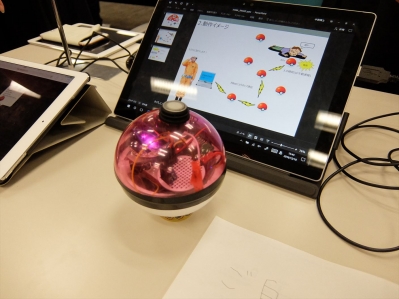Title:ResqueBall - Development code: Joseph
Displayed Name:ResearchKing - Project ResqueBall

| Concept / Overview |
|---|
| This system notifies a server wherescattered individuals are located during a disaster. Sound and motion sensors on GR-COTTON are used to communicate individuals’ location via XBee and GPS. |
The idea behind the gadget & happy users
Background
Now, most everybody has a smartphone and can connect to the Internet no matter where they are.
Moreover, as the term “IoT” gains popularity, not only people, but also things, are linked to the Internet.
Entire towns are overflowing with WiFi, LTE, and 3G networks, so wherever you are, you can easily connect to a network.
However, once a major disaster occurs, electricity supply and communications networks fail, and you simply become isolated.
Beyond the towns, there are lots of other places where one can be out of the range of networks, such as deep in the mountains or out at sea.
If you retain cell phone connectivity and can call for help when victimized by a disaster or accident, it might be relatively easy to be rescued.
Proactive measures such as experimental disaster relief using drones and portable cell phone base stations are currently being developed for use even when communication networks are down.
However, this becomes difficult if individuals do not have, or have lost, their cell phones, or if their location cannot be detected from above.
One example would be if an individual were buried under rubble and unable to call for help even though a rescue squad was at hand.
Another example would be members of a search party looking for individuals stranded in the mountains, but unable to locate them although they were nearby.
Such situations inspired us to create a gadget which could help.
Idea
In a disaster (or when individuals are stranded) when victims are cut off from communications networks, several dozen or several hundred ResqueBalls (see below) could be dropped from the sky.
The balls could be helpful to rescue efforts if they could manage to find victims and report their location.
Expected features of the ResqueBalls:
1. Grid-type wireless communication capability enabling two-way transmissions.
2. Sustainable wireless communication over relatively long distances
(several hundred meters to several kilometers)
3. The ability to identify its location by GPS
4. The ability to detect vibration, infrared rays, etc. to locate victims
5. The ability to detect victim location or report its own location manually (manual button)
6. The ability to withstand being dropped from a high elevation based on capsule shape)
7. The ability to sustain its battery-powered operations extensively (several days to several weeks)
8. Affordability (10,000 yen or less per unit)
If these conditions are fulfilled, ResqueBall should be able to function much like a rescue dog, “sniffing out” (and then reporting) victim locations.
Of course the ResqueBall will inevitably err along the way as it is a prototype, but the goal is for it to contribute to the advancement of disaster relief technology.
The result
Development proceeded as follows through to the finals (exact dates unspecified)
- ZigBee installation for intercommunication and position reporting via GPS sensor
- Installation of feature enabling manual reporting
- Installation of feature enabling motion detection via accelerometer and infrared sensor
- Field test of prototype
- Feedback from field test followed by fine-tuning
/edDir/files/source_package.zip
Demo Video
GR DESIGN CONTEST 2016 Finalist

